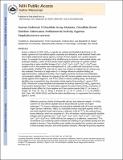Human Defensin 5 Disulfide Array Mutants: Disulfide Bond Deletion Attenuates Antibacterial Activity against Staphylococcus aureus
Author(s)
Wanniarachchi, Yoshitha A.; Kaczmarek, Piotr; Wan, Andrea; Nolan, Elizabeth M.
DownloadNolan_Human defensin.pdf (947.1Kb)
PUBLISHER_POLICY
Publisher Policy
Article is made available in accordance with the publisher's policy and may be subject to US copyright law. Please refer to the publisher's site for terms of use.
Terms of use
Metadata
Show full item recordAbstract
Human α-defensin 5 (HD5, HD5[subscript ox] to specify the oxidized and disulfide linked form) is a 32-residue cysteine-rich host-defense peptide, expressed and released by small intestinal Paneth cells, that exhibits antibacterial activity against a number of Gram-negative and -positive bacterial strains. To ascertain the contributions of its disulfide array to structure, antimicrobial activity, and proteolytic stability, a series of HD5 double mutant peptides where pairs of cysteine residues corresponding to native disulfide linkages (Cys[superscript 3]-Cys[superscript 31], Cys[superscript 5]-Cys[superscript 20], Cys[superscript 10]-Cys[superscript 30]) were mutated to Ser or Ala residues, overexpressed in E. coli, purified, and characterized. A hexa mutant peptide, HD5[Ser[superscript hexa]], where all six native Cys residues are replaced by Ser residues, was also evaluated. Removal of a single native S–S linkage influences oxidative folding and regioisomerization, antibacterial activity, Gram-negative bacterial membrane permeabilization, and proteolytic stability. Whereas the majority of the HD5 mutant peptides show low micromolar activity against Gram-negative E. coli ATCC 25922 in colony counting assays, the wild-type disulfide array is essential for low micromolar activity against Gram-positive S. aureus ATCC 25923. Removal of a single disulfide bond attenuates the activity observed for HD5[subscript ox] against this Gram-positive bacterial strain. This observation supports the notion that the HD5[subscript ox] mechanism of antibacterial action differs for Gram-negative and Gram-positive species [Wei et al. (2009) J. Biol. Chem.284, 29180−29192] and that the native disulfide array is a requirement for its activity against S. aureus.
Date issued
2011-09Department
Massachusetts Institute of Technology. Department of ChemistryJournal
Biochemistry
Publisher
American Chemical Society
Citation
Wanniarachchi, Yoshitha A., Piotr Kaczmarek, Andrea Wan, and Elizabeth M. Nolan. “Human Defensin 5 Disulfide Array Mutants: Disulfide Bond Deletion Attenuates Antibacterial Activity against Staphylococcus aureus.” Biochemistry 50, no. 37 (September 20, 2011): 8005-8017.
Version: Author's final manuscript
ISSN
0006-2960
1520-4995